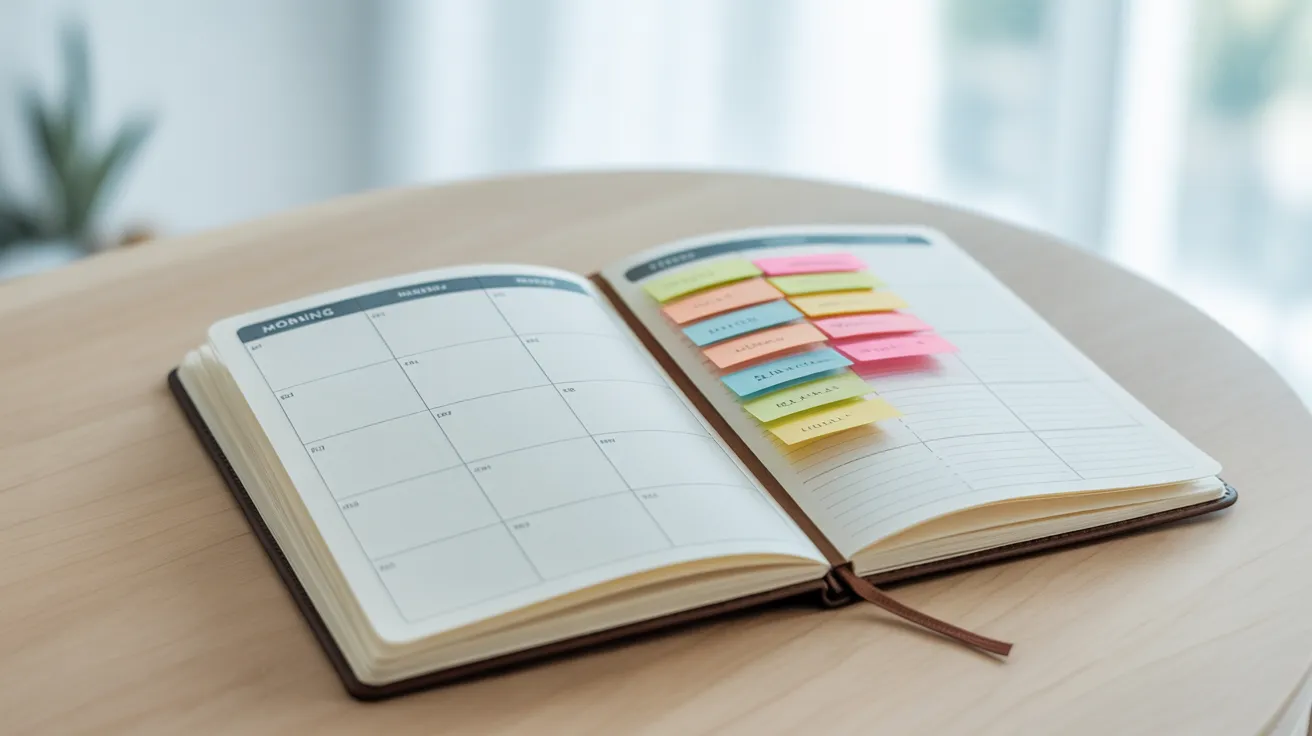
📚 Table of Contents
- 1. The Foundation: Embrace Intentional Time Blocking
- 2. Set Up Your Digital Command Center
- 3. Create Your “Fake” Commute
- 4. Structure Your Day for Peak Energy
- 5. Plan Your Week, Not Just Your Day
- 6. Build Buffers and Embrace Imperfection
- 7. Defend Your Focus: Taming Interruptions
- 8. Master Your Meetings
- 9. The Weekly Review: Your Secret Weapon
- 10. Protect Your Off-Hours Ruthlessly
- Putting It All Together: Two Scenarios
- Frequently Asked Questions
- What if my whole day is filled with meetings?
- How strictly should I stick to my blocks?
- What’s the best tool for this?
- How do I stay motivated when working from home?
- Your First Steps to a Focused Week
The dream of working from home often involves a quiet, sunlit room, a steaming mug of coffee, and unparalleled focus. The reality, especially in a busy urban apartment, is often quite different. It’s the kitchen table that doubles as a desk, the siren wailing past your window during a crucial call, and the blurred line between your workday and your evening. The freedom of remote work can quickly curdle into chaos without a plan. You feel like you’re always working, yet never quite getting enough done.
But what if you could have structure without a straitjacket? What if you could build a productive workday that respects your energy, protects your personal time, and actually fits the realities of your life? You can. At TheFocusedMethod.com, we believe that good time management isn’t about rigid rules; it’s about creating a flexible framework for intention. This guide will walk you through 10 essential, pragmatic tips to help you master the art of being productive while working from home. We will focus on a core method, show you how to set it up, and guide you through the inevitable challenges of a real workday.
1. The Foundation: Embrace Intentional Time Blocking
Before we dive into specific tips, let’s establish our core strategy: time blocking. If you’re not familiar with it, time blocking is the practice of scheduling your entire day into specific blocks of time. Instead of working from a long, intimidating to-do list, you assign each task a home on your calendar. You’re not just deciding what to do; you’re deciding when and for how long you will do it.
Why is this so effective for remote work? Because it combats the two biggest enemies of productivity at home: decision fatigue and distraction. When your day is a wide-open sea of hours, you constantly have to ask, “What should I work on next?” This drains mental energy. Time blocking makes that decision for you ahead of time. You just look at your calendar and execute.
More importantly, it helps you defeat context switching. Context switching is the mental cost of shifting your attention from one task to another unrelated task. Every time you jump from writing a report to answering an email to checking a message, your brain has to re-load the context for that new activity. It’s incredibly inefficient. Research, like that often cited by the American Psychological Association, highlights how multitasking and constant switching can severely reduce productivity. By dedicating a solid block of time to a single type of task, you allow your brain to achieve a state of deep focus, producing higher quality work in less time. This simple scheduling method is the bedrock of a successful work from home routine.

2. Set Up Your Digital Command Center
Your calendar is your new best friend. Whether you use Google Calendar, Outlook, or a physical planner, this is where your time blocking plan will live. The key is to make it a visual, easy-to-read guide for your day. The setup is simple but powerful. Start by creating categories for your work and life, and assign each one a distinct color. This visual separation is crucial for a clear overview.
Here’s a sample color-coding system to get you started:
Deep Work (Blue): These are your most important, high-concentration tasks. Think writing a proposal, coding a new feature, or analyzing complex data. These blocks should be scheduled during your peak energy hours and fiercely protected from interruption.
Shallow Work (Gray): This is for administrative or less demanding tasks. Answering routine emails, filling out expense reports, or organizing files falls into this category. Batching these together in a single block prevents them from peppering and disrupting your deep work sessions.
Meetings & Calls (Yellow): Any scheduled interaction with colleagues or clients. This color helps you see at a glance how much of your day is dedicated to collaboration versus solo work.
Personal & Breaks (Green): This is non-negotiable. Block out time for lunch, short breaks, workouts, and personal appointments. Seeing green on your calendar is a visual reminder that rest is a productive activity. It’s how you refuel for your next focus session.
When you name your blocks, be specific. Instead of a generic “Work” block, label it “Draft Project Alpha Report” or “Respond to Client Emails.” This removes all ambiguity. When the time arrives, you know exactly what to do.

3. Create Your “Fake” Commute
One of the biggest unsung benefits of an office job was the commute. It created a clear, physical, and mental transition between your personal life and your professional one. When you work from home, that boundary evaporates. Your living room is your office, and the “commute” is a ten-step walk from your bed to your desk. This lack of separation is a primary driver of burnout in a remote work setting.
You need to consciously rebuild that boundary. Create a “start of day” and “end of day” ritual that acts as your new commute. This doesn’t have to be complicated. It just needs to be consistent. Your morning “commute” could be a 15-minute walk around the block, a short stretching routine, reading one chapter of a book, or meditating. The activity itself matters less than the intention: this is the official start of your workday.
Your “end of day” commute is even more important. It’s your signal to your brain to clock out. This could involve tidying up your home office space, writing down your top priorities for the next day, changing out of your “work clothes,” or listening to a specific podcast. Once you complete this ritual, work is done. No more checking email on the couch. This simple habit helps you reclaim your evenings and maintain a healthier work-life balance, which is one of the most vital work from home tips for long-term success.

4. Structure Your Day for Peak Energy
Not all hours of the day are created equal. You likely have periods where you feel sharp and focused, and others where you feel sluggish. A successful work from home schedule is built around these natural energy rhythms. For most people, this means tackling the most demanding deep work in the morning.
Let’s walk through a sample day using time blocking:
8:30 AM – 9:00 AM (Green): Your “morning commute.” You go for a quick walk and grab a coffee. You do not check your email yet.
9:00 AM – 11:30 AM (Blue): Deep Work Block. This is a 2.5-hour, uninterrupted session focused on your most important task of the day. You’ve turned off notifications on your phone and computer. You are fully immersed in drafting that critical report.
11:30 AM – 12:30 PM (Gray): Shallow Work Block. You process your email inbox, respond to Slack messages, and handle any quick administrative tasks that have piled up. You’re batching these to be efficient.
12:30 PM – 1:15 PM (Green): Lunch. You step away from your desk. You eat a real meal, preferably not in front of a screen. This break is essential for recharging.
1:15 PM – 2:30 PM (Yellow): Meeting Block. You have your scheduled team check-in and a client call back-to-back. Because you’ve blocked this time, you’re prepared and present for both.
2:30 PM – 4:00 PM (Blue): Secondary Deep Work Block. Your energy might be slightly lower than in the morning, so you tackle a creative but less analytically intense task, like brainstorming ideas for the next quarter.
4:00 PM – 5:00 PM (Gray): Wrap-up Block. You handle final emails, plan your top 1-3 priorities for tomorrow, and clear your workspace. This sets you up for a smooth start the next day.
5:00 PM – 5:15 PM (Green): Your “evening commute.” You close your laptop, put your work notebook away, and go for another short walk or listen to music to decompress.
Notice how this structure uses timeboxing, a related concept where you give yourself a fixed time period to complete a task. This leverages Parkinson’s Law, the adage that work expands to fill the time allotted for its completion. By giving your report a 2.5-hour box, you create a sense of urgency that promotes focus and prevents procrastination.

5. Plan Your Week, Not Just Your Day
A well-planned day is good, but a well-planned week is life-changing. On Friday afternoon or Sunday evening, take 30 minutes to look at the week ahead. This is your chance to be the architect of your time, not just a firefighter battling daily emergencies. During this weekly planning session, you’ll look at your upcoming deadlines and appointments and begin to lay out the big blocks for each day.
This is the perfect time to apply the 80/20 Principle, also known as the Pareto Principle. This concept suggests that, for many outcomes, roughly 80% of the consequences come from 20% of the causes. In your work, this means a small number of your tasks will generate the majority of your results. Your job during the weekly review is to identify that vital 20% of work and ensure it gets a prime “Deep Work” spot on your calendar before anything else.
You can also “theme” your days to reduce context switching on a macro level. For example:
- Monday: Planning & Strategy Day (Review metrics, set weekly goals, internal alignment meetings).
- Tuesday & Wednesday: Deep Work / Focus Days (Large blocks of uninterrupted time for major projects).
- Thursday: Collaboration Day (Schedule most client calls and external meetings).
- Friday: Wrap-up & Admin Day (Handle expenses, clean your inbox, conduct your weekly review, and plan the next week).
This approach creates a predictable rhythm, making your remote work schedule more sustainable and less chaotic. You know what kind of energy to bring to each day.

6. Build Buffers and Embrace Imperfection
Here’s where a pragmatic approach differs from a rigid one. Your beautifully planned calendar will inevitably collide with reality. A call will run over. A task will be more complex than you estimated. Your child will get sick. If your schedule is packed back-to-back with no breathing room, a single disruption can derail your entire day.
The solution is to schedule imperfection. Build buffers into your day. A buffer is a small, unassigned block of time between scheduled events. For example, if you have meetings from 10:00-11:00 AM and 11:30 AM-12:00 PM, that 30-minute gap is a buffer. It gives you time to decompress, grab water, review notes for the next call, or handle an urgent two-minute task that popped up. Without it, you’d be rushing and frazzled.
It’s also wise to schedule a 30-45 minute “overflow” or “contingency” block in the late afternoon. This is your safety valve. If your morning report took longer than expected, you use this block to finish it. If everything went according to plan, you can use this time to get ahead on tomorrow’s work, do some professional development, or simply end your day a bit early. Having this buffer reduces stress and makes your entire system more resilient and realistic for the unpredictable nature of work from home.

7. Defend Your Focus: Taming Interruptions
Your home office is filled with potential interruptions, both digital and physical. Learning how to work productively from home means becoming a ruthless defender of your focused time blocks. This requires a two-pronged approach.
First, conquer digital distractions. When you enter a “Deep Work” block, be merciless. Turn off email and chat notifications on your computer. Put your phone in another room or turn on “Do Not Disturb.” Close any browser tabs that are not directly related to the task at hand. The momentary discomfort of being “unreachable” is a small price to pay for hours of high-quality, focused output.
Second, manage physical interruptions. This is a common challenge for those sharing their space. Communication is key. Let your family, partner, or roommates know your schedule. You can say, “I’m in a focus block from 9:00 to 11:30. Unless it’s an emergency, can we talk after that?” A closed door can be a powerful signal, as can wearing headphones, even if you’re not listening to anything. Setting these gentle but firm boundaries is essential for protecting the integrity of your work blocks.

8. Master Your Meetings
Meetings can be the single greatest threat to a productive remote workday. They fragment your calendar, create massive context switching, and often lack clear purpose. To make your time blocking system work, you must get control of your meetings.
Start by questioning every meeting. Before accepting an invitation, ask yourself (or the organizer) if the goal could be achieved via an email, a shared document, or a quick chat message. You’ll be surprised how often the answer is yes. If a meeting is necessary, ensure it has a clear agenda and a defined outcome. A meeting without an agenda is just a conversation; it’s not a productive use of time.
Use your calendar to your advantage. Block off “meeting-free” times, especially during your peak energy morning hours. Try to group your necessary meetings into a single “Meeting Block” in the afternoon. This batching prevents them from scattering across your day like shrapnel. Finally, always schedule 15 minutes before a significant meeting for preparation and 15 minutes after for debriefing and actioning next steps. This makes the meeting itself, and the time around it, far more effective.

9. The Weekly Review: Your Secret Weapon
A plan is only useful if you learn from it. The most critical habit for long-term productivity is the weekly review. This is a 30-minute, non-negotiable appointment you have with yourself every Friday afternoon. During this time, you’ll look back at your calendar from the past week and ask a few simple questions:
- What went well? Where did I feel most focused and energized?
- What didn’t go as planned? Which tasks took longer than expected? Where was I most distracted?
- What will I change next week to have a better outcome?
This is not about judging yourself; it’s about gathering data. Look at your “rollover rate”—how many tasks did you have to push to the next day? If it’s high, your blocks might be too optimistic, or you’re not protecting your focus time well enough. Pay attention to your energy levels. Did that afternoon deep work block feel productive, or were you just staring at the screen? Maybe it’s better used for shallow work next week. This feedback loop is what turns time blocking from a rigid system into a dynamic, personalized productivity tool that evolves with you.

10. Protect Your Off-Hours Ruthlessly
The ultimate goal of being more productive during your work hours is to be able to fully disconnect when you’re not working. The blurring of boundaries is a significant contributor to stress and burnout, an issue frequently studied by organizations like the National Institutes of Health. Your productivity system is failing if it just leads to you working more hours.
This is where your “end of day” ritual becomes sacred. When you’ve completed your shutdown routine, work is over. The laptop stays closed. You don’t check emails on your phone while making dinner. This separation is crucial for your mental health and cognitive recovery. Your brain needs downtime to process information, consolidate learning, and recharge for the next day. Furthermore, protecting your evenings ensures you can get adequate rest. The link between sleep and cognitive performance is undeniable, as detailed by resources like the Sleep Foundation. A great workday starts with a good night’s sleep, and that can only happen if you truly switch off.

Putting It All Together: Two Scenarios
Scenario 1: The Hybrid Professional
Maria is a marketing manager who works from her city apartment three days a week and goes into the office two days. Her challenge is managing context switching between home and office. On her WFH days, she themes her schedule. Monday (WFH) is for deep work: she blocks 9 AM-12 PM for strategy document writing, with all notifications off. She uses the afternoon for shallow work and planning her in-office days. Tuesday and Thursday are her in-office days, which she designates for collaborative meetings and team brainstorming. Wednesday (WFH) is her “catch-up and focus” day, where she works on projects that were discussed in the office. This thematic approach ensures she leverages the unique benefits of each environment—quiet focus at home, dynamic collaboration at the office.
Scenario 2: The University Student
David is a university student with a mix of online classes, in-person labs, and a part-time job. His schedule is variable. He uses time blocking to bring order to the chaos. He color-codes his calendar: Blue for “Study Blocks,” Yellow for “Classes/Labs,” Red for “Job,” and Green for “Breaks/Social.” He identifies his peak energy time (late morning) and always reserves a 2-hour “Study Block” then for his most difficult subject. He treats his study blocks like appointments he cannot miss. He also schedules 30-minute buffers after his labs to travel back to his dorm and decompress before starting his next task. This prevents him from feeling constantly rushed and behind.

Frequently Asked Questions
What if my whole day is filled with meetings?
If your calendar is wall-to-wall meetings, the problem is less about time management and more about role management. First, audit your meetings mercilessly. Can you decline some? Can you send a delegate? Can you get the information asynchronously? Second, start blocking off “focus time” on your calendar weeks in advance. If it’s on your calendar, colleagues are less likely to schedule over it. Treat this focus time as an unbreakable appointment with your most important work.
How strictly should I stick to my blocks?
The plan is a guide, not a prison. The goal is intention. If you’re in a state of flow on a deep work task and the block is about to end, it’s often wise to continue for another 15-30 minutes if you can. Conversely, if a task finishes early, you can move on to the next one or enjoy a short break. The key is to be the one making the conscious decision, rather than letting distractions make it for you. Aim for about 80% adherence; that’s a huge win.
What’s the best tool for this?
The best tool is the one you will use consistently. Google Calendar is excellent and free. Outlook Calendar is great for corporate environments. Some people prefer physical planners like The Full Focus Planner. Don’t spend weeks researching the “perfect” app. Pick one, set up your color-coded categories, and start blocking. You can always switch later if you find it isn’t working for you.
How do I stay motivated when working from home?
Motivation can be tough without the social energy of an office. Time blocking helps because it creates small, achievable wins throughout the day. When you complete a block, you get a sense of accomplishment. Your “fake commute” helps by creating clear start and end points, preventing the day from feeling like an endless slog. Finally, be sure to block in things you enjoy during your breaks—a short walk, listening to music, or calling a friend. This makes the entire process more sustainable and enjoyable.

Your First Steps to a Focused Week
Feeling overwhelmed? Don’t try to implement everything at once. Here are three simple actions you can take this week to start your journey to a more productive remote work life.
1. Choose Your Colors: Open your digital calendar right now and create 4-5 color-coded categories: Deep Work, Shallow Work, Meetings, and Personal/Breaks. This takes five minutes and is the first step to visualizing your time.
2. Block Your Big Rock: Identify your single most important task for tomorrow. Block out a 90-minute, uninterrupted session on your calendar to work on it. Schedule it during your peak energy time.
3. Plan Your “Commutes”: Decide on one simple 15-minute activity to start your workday and one to end it tomorrow. Commit to doing them. This small act will have an outsized impact on your work-life balance.
Mastering how to work productively from home is a skill. It takes practice, adjustment, and self-compassion. But by building a framework of intention with time blocking, you can trade chaos for control, distraction for focus, and create a remote work life that is not only productive, but also fulfilling.
Disclaimer: The information provided in this article is for informational purposes only and does not constitute medical, psychological, or legal advice. Please consult with a qualified professional for advice tailored to your specific situation.






